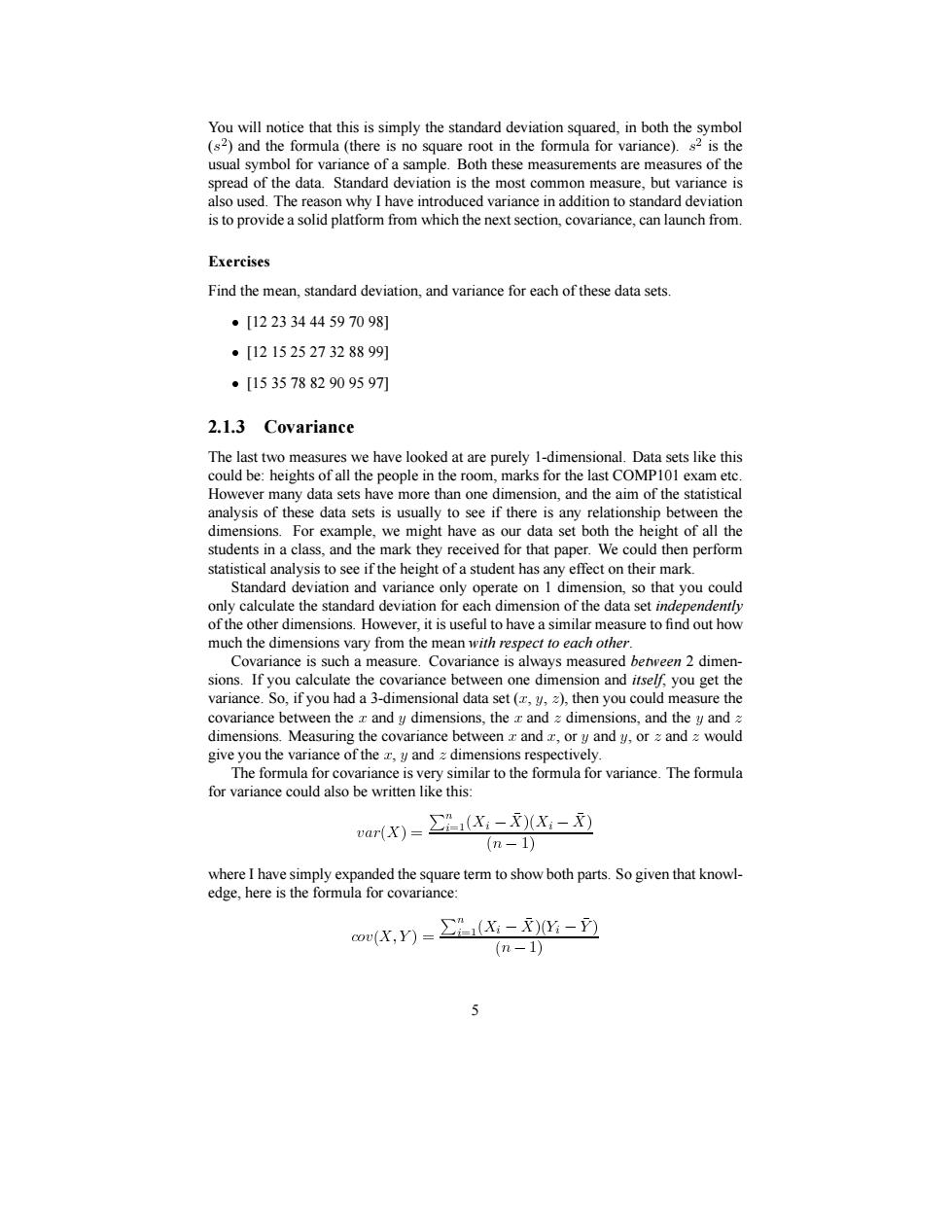正在加载图片...

You will notice that this is simply the standard deviation squared,in both the symbol (s2)and the formula(there is no square root in the formula for variance).s2 is the usual symbol for variance of a sample.Both these measurements are measures of the spread of the data.Standard deviation is the most common measure,but variance is also used.The reason why I have introduced variance in addition to standard deviation is to provide a solid platform from which the next section,covariance,can launch from. Exercises Find the mean,standard deviation,and variance for each of these data sets. ·[12233444597098] ·[12152527328899] ·[15357882909597] 2.1.3 Covariance The last two measures we have looked at are purely 1-dimensional.Data sets like this could be:heights of all the people in the room,marks for the last COMP101 exam etc. However many data sets have more than one dimension,and the aim of the statistical analysis of these data sets is usually to see if there is any relationship between the dimensions.For example,we might have as our data set both the height of all the students in a class,and the mark they received for that paper.We could then perform statistical analysis to see if the height of a student has any effect on their mark. Standard deviation and variance only operate on I dimension,so that you could only calculate the standard deviation for each dimension of the data set independently of the other dimensions.However,it is useful to have a similar measure to find out how much the dimensions vary from the mean with respect to each other. Covariance is such a measure.Covariance is always measured between 2 dimen- sions.If you calculate the covariance between one dimension and itself,you get the variance.So,if you had a 3-dimensional data set(,y,z),then you could measure the covariance between the and y dimensions,the x and z dimensions,and the y and z dimensions.Measuring the covariance between z and z,or y and y,or z and z would give you the variance of the z,y and z dimensions respectively. The formula for covariance is very similar to the formula for variance.The formula for variance could also be written like this: var(X)= ∑(X:-x)(X:-) (n-1) where I have simply expanded the square term to show both parts.So given that knowl- edge,here is the formula for covariance: X,)=∑是X-出- (n-1) 5You will notice that this is simply the standard deviation squared, in both the symbol (✴ ✹ ) and the formula (there is no square root in the formula for variance). ✴ ✹ is the usual symbol for variance of a sample. Both these measurements are measures of the spread of the data. Standard deviation is the most common measure, but variance is also used. The reason why I have introduced variance in addition to standard deviation is to provide a solid platform from which the next section, covariance, can launch from. Exercises Find the mean, standard deviation, and variance for each of these data sets. ❀ [12 23 34 44 59 70 98] ❀ [12 15 25 27 32 88 99] ❀ [15 35 78 82 90 95 97] 2.1.3 Covariance The last two measures we have looked at are purely 1-dimensional. Data sets like this could be: heights of all the people in the room, marks for the last COMP101 exam etc. However many data sets have more than one dimension, and the aim of the statistical analysis of these data sets is usually to see if there is any relationship between the dimensions. For example, we might have as our data set both the height of all the students in a class, and the mark they received for that paper. We could then perform statistical analysis to see if the height of a student has any effect on their mark. Standard deviation and variance only operate on 1 dimension, so that you could only calculate the standard deviation for each dimension of the data set independently of the other dimensions. However, it is useful to have a similar measure to find out how much the dimensions vary from the mean with respect to each other. Covariance is such a measure. Covariance is always measured between 2 dimensions. If you calculate the covariance between one dimension and itself, you get the variance. So, if you had a 3-dimensional data set (❁, ❂, ❃), then you could measure the covariance between the ❁ and ❂ dimensions, the ❁ and ❃ dimensions, and the ❂ and ❃ dimensions. Measuring the covariance between ❁ and ❁, or ❂ and ❂, or ❃ and ❃ would give you the variance of the ❁, ❂ and ❃ dimensions respectively. The formula for covariance is very similar to the formula for variance. The formula for variance could also be written like this: ❄ ✭✰❅ ✵❆✷✟✁ ✦✧✾★ ✛ ✵ ✧ ✲ ✸✷ ✤ ✵ ✧ ✲ ❆✷ ✤ ✵✣✿✲ ✆✒✷ where I have simply expanded the square term to show both parts. So given that knowledge, here is the formula for covariance: ❇✫❈❉❄ ✵✽❊✰❋✍✷●✁ ✦✧✾★ ✛ ✵ ✧ ✲ ✸✷ ✤ ✵❋ ✧ ✲ ❋✍✷ ✤ ✵✣✳✲ ✆✏✷ 5